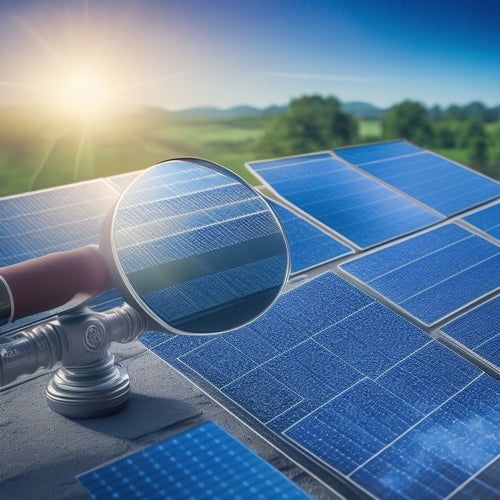
Why Intelligent Homes Need Smart Energy Management
Share
You invest in intelligent home technology and sustainable energy sources, but inefficient consumption patterns waste up to 30% of your energy. To optimize energy usage, you need smart energy management. This involves utilizing advanced data analytics and machine learning algorithms to detect patterns and anomalies in energy usage data. By implementing peak shaving, load shifting, and automated energy-saving strategies, you can minimize waste and reduce your environmental footprint. With smart energy management, you can make data-driven decisions, optimize energy usage for grid resiliency, and save money on energy bills. Explore how to harness the full potential of your intelligent home.
Key Takeaways
• Intelligent homes require smart energy management to optimize energy consumption patterns and reduce waste through advanced data analytics and machine learning algorithms.
• Smart energy management helps identify areas of inefficiency and opportunities for energy savings, ensuring efficient solar power usage and reducing environmental footprint.
• Real-time energy monitoring enables data-driven decisions, pinpointing energy-wasting patterns, and detecting anomalies in energy usage for issue detection and correction.
• Automated energy-saving strategies, such as load forecasting and scheduling, minimize energy waste and optimize appliance performance for maximum efficiency.
• Seamless energy storage integration ensures a steady supply of clean energy, reduces reliance on the grid during peak hours, and performs regular battery maintenance for efficient energy storage.
Optimizing Energy Consumption Patterns
By leveraging advanced data analytics and machine learning algorithms, you can identify and optimize your energy consumption patterns, pinpointing areas of inefficiency and opportunities for significant energy savings. By analyzing your energy usage data, you can detect patterns and anomalies that might be driving up your energy bills.
For instance, you might find that your energy consumption peaks during certain hours of the day, such as when your family is getting ready for work or school. This is where peak shaving comes in – by reducing your energy consumption during these peak hours, you can avoid high energy bills and reduce strain on the grid.
Additionally, you can engage in load shifting, where you shift non-essential energy-intensive tasks to off-peak hours, such as running your dishwasher or washing machine at night. By optimizing your energy consumption patterns, you can create a more efficient and sustainable energy profile for your home, reducing your environmental footprint and saving you money in the long run.
Ensuring Efficient Solar Power Usage
As you optimize your energy consumption patterns, you can further maximize your energy savings by making sure your solar power system is operating at peak efficiency, which requires careful monitoring and management of your solar panel's performance.
To guarantee efficient solar power usage, it's crucial to:
-
Track energy harvesting: Monitor your solar panel's energy output to identify any performance issues or opportunities for improvement.
-
Optimize panel orientation and tilt: Ensure your solar panels are angled and positioned to maximize energy harvesting during peak sunlight hours.
-
Perform regular maintenance: Clean your solar panels regularly to prevent dust and debris from reducing energy output.
Real-time Energy Monitoring Benefits
You can pinpoint energy-wasting patterns and opportunities for improvement with real-time energy monitoring, which provides instant feedback on your energy consumption habits. This level of energy transparency enables you to make data-driven decisions, reducing your environmental footprint and saving you money on your energy bills.
With real-time monitoring, you can identify areas of inefficiency and optimize your energy usage to guarantee grid resiliency. This is particularly important for homeowners with solar panels, as it allows you to maximize your energy harvesting and reduce reliance on the grid.
By gaining a deeper understanding of your energy consumption, you can adjust your habits and make conscious choices about your energy usage. Real-time monitoring also enables you to detect anomalies in your energy usage, allowing you to identify potential issues before they become major problems.
Automated Energy Saving Strategies
Intelligent home systems implement automated energy saving strategies, leveraging advanced algorithms and machine learning to optimize energy usage and minimize waste. By analyzing your energy consumption patterns, these systems can identify opportunities to reduce energy waste and optimize your energy usage.
Here are some ways automated energy saving strategies can benefit you:
-
Load forecasting: By predicting your energy needs, your intelligent home system can adjust energy production and consumption accordingly, ensuring you're not wasting energy when you don't need it.
-
Device scheduling: Your system can schedule device usage during off-peak hours, reducing energy consumption during peak hours when energy rates are higher.
-
Smart appliance control: Your system can optimize appliance performance, turning off unused devices and adjusting settings for maximum efficiency.
Seamless Energy Storage Integration
By integrating energy storage solutions into your intelligent home system, it can optimize energy harvesting and reduce reliance on the grid during peak hours. This means you'll have a steady supply of clean energy, even when the grid is strained.
Seamless energy storage integration allows your system to automatically switch between grid power and stored energy, ensuring a smooth shift. This not only reduces your energy bills but also helps the environment by decreasing your carbon footprint.
To guarantee efficient energy storage, your system will perform regular battery maintenance tasks, such as monitoring charge cycles and adjusting charging rates. This ensures your batteries remain healthy and efficient, prolonging their lifespan.
Additionally, grid synchronization capabilities enable your system to synchronize with the grid's frequency and voltage, ensuring a stable and efficient energy supply. With seamless energy storage integration, you can rest assured that your intelligent home is always optimized for energy efficiency and sustainability.
Frequently Asked Questions
Can Smart Energy Management Systems Integrate With Existing Home Automation?
You can seamlessly integrate smart energy management systems with your existing home automation setup, thanks to device compatibility and system flexibility, ensuring a cohesive and efficient smart home experience.
How Do I Ensure Cybersecurity in Smart Energy Management Systems?
To safeguard your smart energy management system, you'll want to implement robust encryption protocols and network segmentation, ensuring that sensitive data remains confidential and out of reach from potential cyber threats, giving you peace of mind.
Are Smart Energy Management Systems Compatible With All Energy Providers?
You'll find that most smart energy management systems are designed to be compatible with various energy providers, thanks to utility partnerships and adherence to universal energy standards, ensuring seamless integration and data exchange.
Can I Control My Smart Energy Management System Remotely?
Imagine you're on a beach vacation, but your mind is back home, worrying about energy waste. Fear not! With remote access, you can control your smart energy management system from afar, ensuring energy efficiency and peace of mind.
Do Smart Energy Management Systems Require Professional Installation?
When considering a smart energy management system, you'll find that while some systems allow for DIY installation, others require professional installation, depending on the complexity of the system, which affects installation costs, so it is crucial to weigh your options carefully.
Related Posts
-

Essential Accessories for Heavy Riders of E-Bikes
As a heavy rider of an e-bike, you need specialized gear that caters to your unique needs. Start with safety essentia...
-

Charging Points in Rural Areas: 5 Key Insights
When driving through rural areas, you'll face a shortage of charging points, making EV ownership stressful and inconv...
-

Solar Panel System Certification Costs: A 10-Point Breakdown
You're looking to understand the costs associated with solar panel system certification. Your total certification cos...


